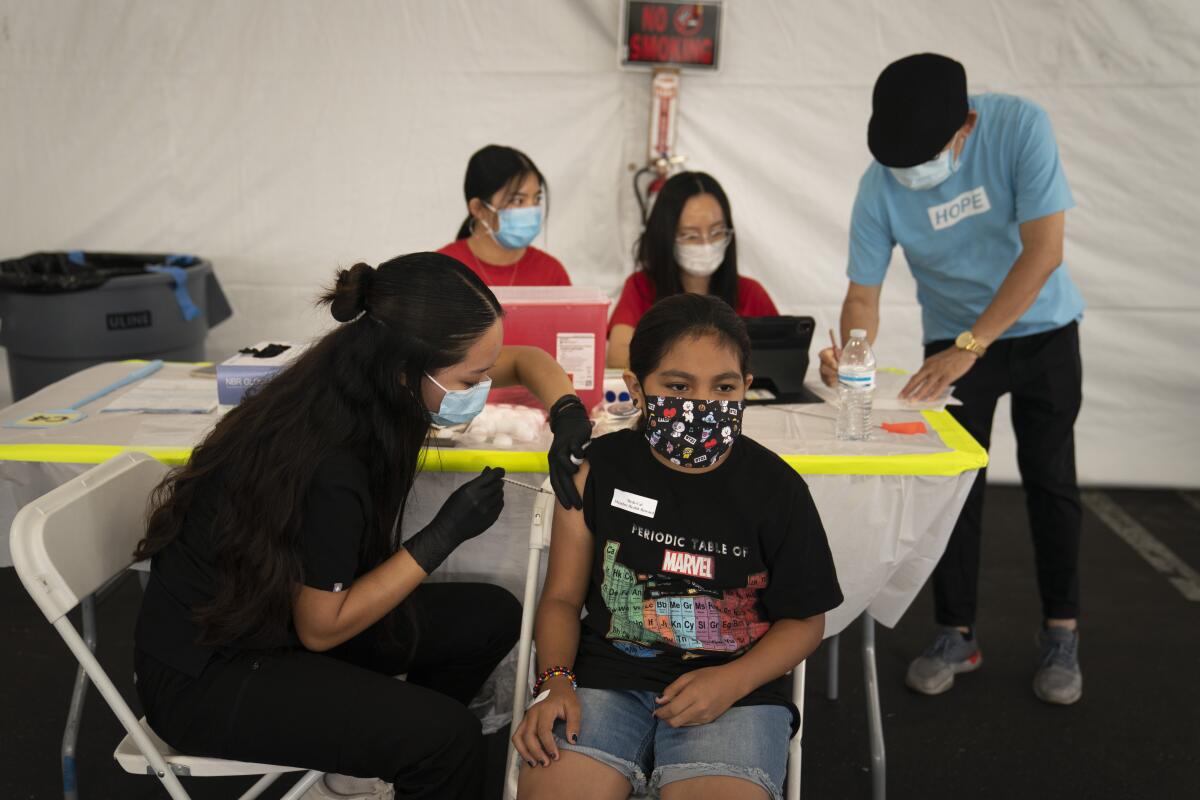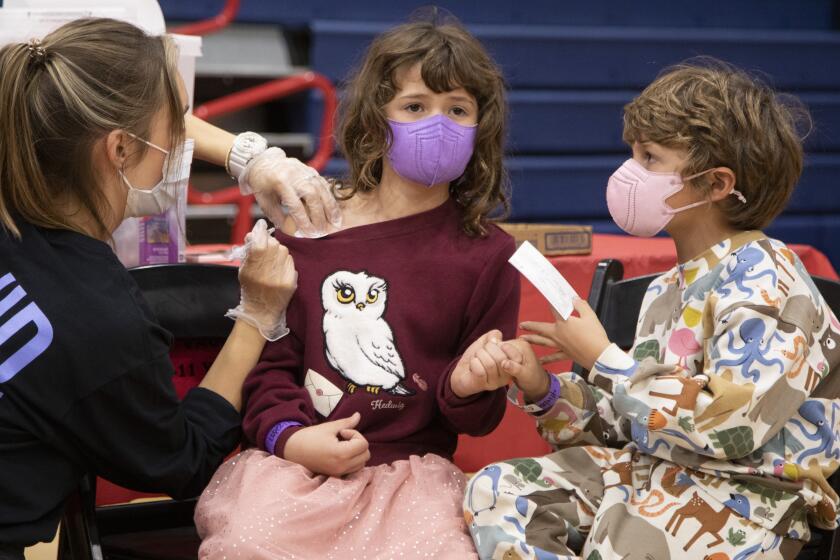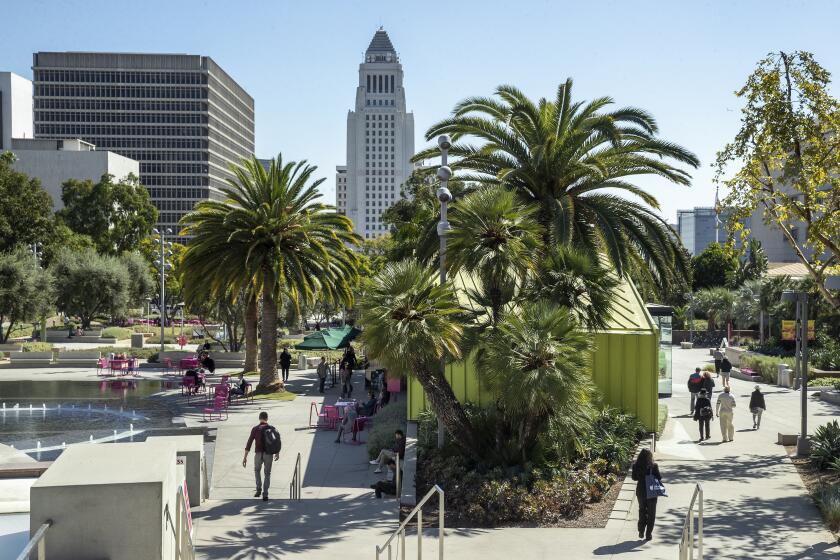How worried should California be about another winter COVID-19 surge? What we know

- Share via
There are continued concerns that California could see a resurgence of COVID-19 over the coming weeks and months.
What that might look like, and how severe it may ultimately turn out to be, remains an open question.
Officials and experts largely agree that California is unlikely to see a surge that reaches the grim heights of last winter’s — which overloaded hospitals with COVID-19 patients and killed tens of thousands statewide — largely because many residents are already vaccinated.
But a spike in cases during the winter months, when temperatures fall and a packed holiday calendar might tempt residents to travel and mingle without taking appropriate precautions, is still a real possibility.
“With cases ticking up in most parts of the state, we cannot let our guard down, and we cannot underestimate this deadly virus,” Dr. Tomás Aragón, director of the California Department of Public Health and the state’s public health officer, said in a statement Monday.
California has yet to fully shake off the Delta surge, and there are signs conditions are headed in the wrong direction in parts of the state.
Here’s a breakdown of where we are.
What is the concern going into the winter holidays?
Health officials have been warning about a potential new rise in COVID-19 cases in California as seniors who got their shots last winter — and haven’t received a booster shot — may start to see their immunity wane, leaving them exposed to greater risk for infection and hospitalization, and as people gather indoors more with cooling weather and approaching holidays.
Demand for booster shots has fallen below expectations in California. And each infected Californian is increasingly spreading the coronavirus to more people.
As of Saturday, computer models estimated that every infected Californian was spreading the virus on average to 0.96 other people. If that number rises above 1, that will set the stage for further growth of the pandemic.
Officials are hopeful that strict vaccination requirements in some of California’s most populated areas will help slow the spread of cases in the winter. In Los Angeles, a new city rule generally requiring patrons to show proof of full vaccination to enter venues such as indoor restaurants, gyms, movie theaters, and hair and nail salons went into effect Monday but won’t be enforced until after Thanksgiving.
COVID hospitalizations go up in Riverside, San Bernardino and Fresno counties, where vaccination rate is low; and in Orange County, where it’s higher.
What is the situation on the ground?
Statewide, infections and COVID-19 hospitalizations have plateaued following months of decline.
But in some areas with lower vaccination rates, hospitalizations for COVID-19 have risen significantly since mid-October: by 35% in San Bernardino County and 27% in Fresno County. Even in Orange County, where vaccination rates are relatively high, COVID-19 hospitalizations are up by 29% over the same time period.
The San Joaquin Valley is reporting the state’s highest rate of COVID-19 hospitalizations; for every 100,000 residents, the region has 25 people hospitalized with COVID-19, compared with 15 per 100,000 in rural Northern California, 14 in the greater Sacramento area, eight in Southern California and four in the San Francisco Bay Area.
Some experts say a rate of five or greater is concerning.
In Southern California, San Bernardino and Riverside counties are reporting the worst hospitalization rates per 100,000 residents: 15 and 10, respectively. San Diego County is at eight, Orange County seven, L.A. County six and Ventura County four.
L.A. requires proof of COVID-19 vaccination to enter indoor restaurants, malls, theaters, salons, coffee shops, gyms, museums, performance venues and other spaces.
How do we compare to 2020?
On Nov. 8, 2020, California reported a seven-day average of 6,200 new coronavirus cases a day. One month later, the state was reporting 26,000 new cases a day. In early January, the number jumped to more than 45,000. Daily reported caseloads didn’t consistently fall back below 10,000 until mid-February.
Current case rates are roughly the same as last year at this time. For the seven-day period that ended Monday, California was reporting 5,720 new coronavirus cases a day, according to data compiled by The Times.
Where is California on vaccinations?
Nearly 62% of Californians are fully vaccinated.
However, there are millions of residents statewide who have less protection against the coronavirus. Given the evidence that vaccine immunity can wane over time, officials stress that it’s important for everyone eligible — particularly those who are at high risk of severe COVID-19 symptoms — to get a booster shot.
Unvaccinated Californians continue to be disproportionately affected by the pandemic, state data show. Unvaccinated individuals are roughly seven times more likely to get COVID-19, 10 times more likely to require hospitalization and 17 times more likely to die than those who are vaccinated.
COVID-19 deaths rose by 10% in Europe in the last week, making it the only region of the world where coronavirus cases and fatalities are increasing.
What is the national picture?
The biggest concentration of coronavirus cases has expanded from Montana, North Dakota and Wyoming and is spreading farther south, through Colorado, Utah, New Mexico and Arizona.
States with low vaccination rates, such as Wyoming, where only 44.5% of residents are fully vaccinated, are seeing among the nation’s highest case rates, as are several states with vaccination rates similar to California’s 61.9%, such as Colorado at 62.1%, New Mexico at 62.6% and Minnesota at 61.6%, said Dr. George Rutherford, a UC San Francisco epidemiologist and infectious diseases expert.
“Even in highly vaccinated places like New Hampshire and Vermont, you can see how these northernmost tiers of counties are starting to develop outbreaks and more transmission, as is Alaska,” Rutherford said recently at a UC San Francisco forum.
That’s why Colorado, New Mexico and Minnesota could be warning signs of California’s future, Rutherford said. Those three states have weekly coronavirus case rates that are triple what California is reporting now. Wyoming’s is more than 3½ times worse than California’s.
Rutherford said that relatively speaking, L.A., Orange and Ventura counties are doing well. But he warned that San Diego, Riverside and San Bernardino counties have a fairly high level of cases.
These factors all suggest that unvaccinated people should get their shots, including children ages 5 to 11 who just became eligible last week, Rutherford said.
People who have recovered from COVID-19 still need to get immunized, too. A study published by the U.S. Centers for Disease Control and Prevention said COVID-19 survivors who remained unvaccinated were five times more likely to get a new coronavirus infection compared with fully vaccinated people who had never been infected.
More to Read
Sign up for Essential California
The most important California stories and recommendations in your inbox every morning.
You may occasionally receive promotional content from the Los Angeles Times.



















